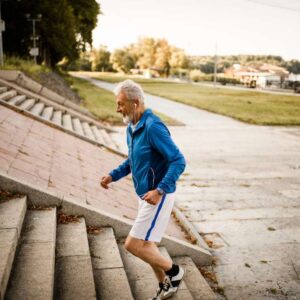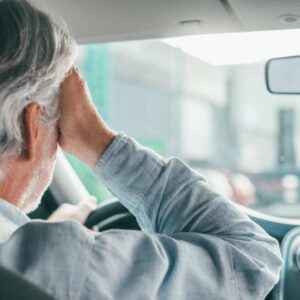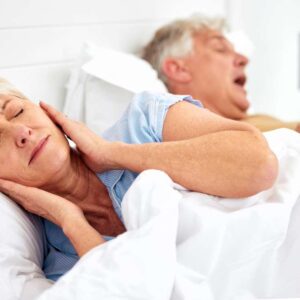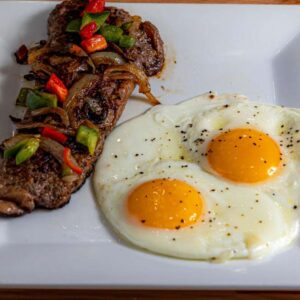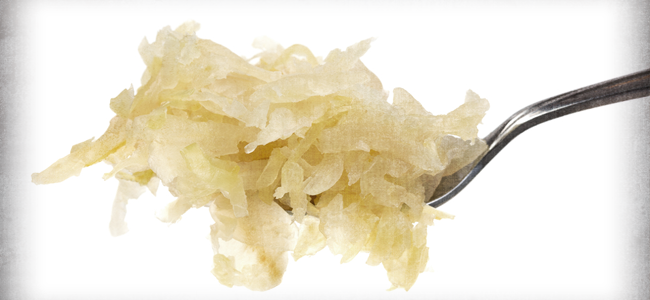
Gott im Himmel! That’s Good Sauerkraut!
“I’ve got something you really need to try.”
Five years ago, Andrew Weil, MD, invited me into the kitchen of his Tucson kitchen, spoke these fateful words, and gave me a conspiratorial wink.
I was at his home to discuss a writing project. But aside from being America’s best-known authority on natural health and healing, Weil was — and is — a brilliant and dedicated gastronome:
- Exhibit one: He has his own chain of hugely successful True Food Kitchen restaurants
- Exhibit two: His kitchen has a walk-in refrigerator.
So the implied question — should we keep grinding on the literary front or stuff our pie holes? — was a no-brainer.
“Bring it,” I said.
Retreating to his pantry, he emerged with a 14-inch-tall ceramic crock. Its top was a circular trench filled with water. The heavy lid’s rim sat in this trench, forming an airtight seal.
He removed the lid, pulled two C-shaped ceramic stones from the interior, and then spooned a generous portion of light-green cabbage for me and one for himself.
“When I was a kid growing up in Philadelphia, the German delis had sauerkraut just like this, actively fermenting in huge barrels,” he said, stabbing his portion with a fork.
Yeah, whatev, I thought. I’d had plenty of canned sauerkraut as a kid. Limp, vinegary, and salty as squid tears. However…
When I took a bite, I knew that I should have trusted the good doctor. Revelation! Teutonic redemption! Crunchy! Piquant! With just enough salt to make it sing!
Gott im Himmel, that’s good sauerkraut!
It was a life-changing moment. Shortly afterward, my wife, Laurie, and I bought this fermenting crock and began chucking all manner of shredded vegetation inside.
While we’ve tried Korean kimchi and various other fermented dishes, we keep returning to making plain sauerkraut.
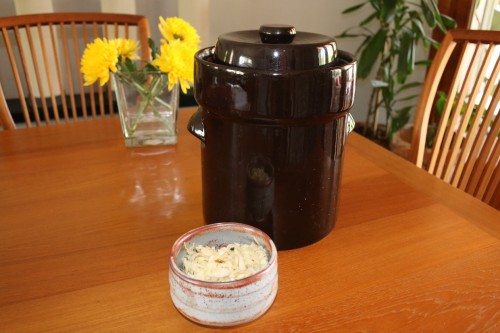
It’s delicious and nutritious — a rich source of B-complex, C, and K vitamins; calcium and magnesium; and dietary fiber.
But most importantly, raw sauerkraut is a rich source of live lactobacilli, the organisms that impart its characteristic sour flavor. Eating it supports the growth of healthy gut flora — which is, in turn, increasingly understood to be the foundation of robust physical and even mental health.
In fact, several studies link frequent raw sauerkraut consumption to lowered cancer risk.1
So… you can buy sauerkraut with live cultures, but at north of $7 a pound, it’s no bargain.
Fortunately, making it at home is simplicity itself.
Shred two heads of fresh cabbage either with a sharp knife or food processor. Mix in a large bowl with roughly 3 tablespoons of salt. Pack the salted shreds in the crock. Press hard with your fist.
Place the two half-circle-shaped ceramic weights (these come with fermenting crocks; a heavy plate will also work) on top of the cabbage.
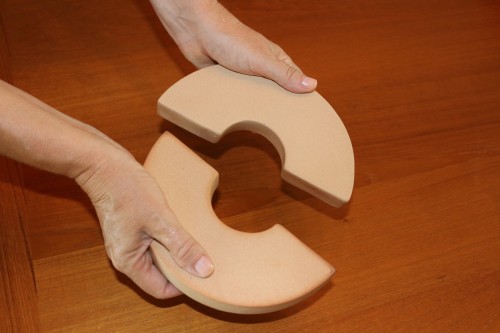
Fill the crock’s rim-trough with water and put on the lid. This forms a one-way seal. Carbon dioxide from the fermenting process can bubble out, but fresh air — which may foster mold growth — can’t get in.
If visible brine does not form naturally within 24 hours, add salted water — roughly 1 teaspoon of salt per cup — until the weights are barely covered.

Now comes the hard part — patience!
Good sauerkraut takes time. At our typical kitchen temperature of about 74 degrees, it’s tasty at three weeks, but perfect at four and good for at least six.
Once it tastes right, it can go into fridge, covered, for several weeks more. And don’t forget to drink the juice, which offers many of the same therapeutic effects as the fermented cabbage itself.
I hope you enjoy your sauerkraut journey as much as Laurie and I have. To this day, we offer enduring thanks to our friend Andrew Weil for showing us the way.
Regards,

Brad Lemley
Editor, Natural Health Solutions
[1] EurekAlert. “Sauerkraut contains anticancer compound.” 2002
Written By Brad Lemley
Brad Lemley is a science and health writer and former senior correspondent for The Washington Post and Discover magazine. He is a tireless advocate for safe, natural, self-directed healthy living practices and therapies.
View More Free Articles
A New Reason to Ditch Processed Junk
If you’ve ever walked the inside aisles of your local grocery store and thought, “This is all just junk,” your instincts were spot on. A new study published in the journal Thorax just added another red flag to the list of dangers linked to ultra-processed food—a 41 percent higher risk of lung cancer. That’s right....
When Being Winded on Stairs Is Serious (And When It Isn’t)
I had an athlete visit me recently because he experienced shortness of breath while climbing stairs. He is in great shape, so he was worried about what it might mean. “Doc,” he said, “I run five miles three times a week. Why am I huffing and puffing after two flights of stairs?” His concern is...
Study EXPOSES Hidden Danger Lurking in Your Car
We think of our homes and cars as safe havens. But according to a startling new study, they may be flooding your lungs with microscopic plastic particles—every single day. Researchers in France recently found that adults inhale an average of 68,000 microplastic particles daily from indoor air alone. To put that in perspective, that’s about...
Mailbag: Is Modern Food Making You Snore?
“What can cause snoring, and is there a way to correct this issue?” —Seeking Silence Hi Seeking, Snoring happens when the soft tissues in your throat relax and vibrate as air passes through during sleep. While several factors can cause snoring—from sleep position to nasal congestion—I want to share one trigger that might surprise you....
Simple Food Swap SLASHES Dementia Risk 28%
Let’s be honest… who would jump at the chance to cut their dementia risk by 28 percent. And no, you don’t need to run marathons, survive on broccoli, or learn to play the zither (whatever that is) to make it happen. All it takes is one easy swap—something that’s probably already in your refrigerator. Researchers...
This SMART Floss Exposes Hidden Health Danger
Scientists have created dental floss that doesn’t just clean between your teeth—it also tracks your stress while you’re flossing. Now, I know what you’re thinking… “Great—now even flossing is going to stress me out by telling me how stressed I am.” But this fascinating new tool from Tufts University could be a game-changer for understanding...
Is This "Safe" Sweetener Damaging Your Brain?
The headlines are alarming… “Popular Sugar Substitute Linked to Brain Cell Damage” and “Erythritol Could Damage Critical Brain Barrier” are just two of the dozens I’ve spotted recently. But before you toss every sugar-free product in your pantry, let’s take a closer look at what this study actually shows—and what it doesn’t. The latest research...
This Summer Threat Could SPIKE Your Blood Sugar
Picture this… It’s another scorching hot summer day. You crank up the air conditioning while watching the weather forecast, which predicts yet another “record-breaking” heat wave. It’s starting to feel like just another miserably uncomfortable summer. But what you might not realize is that—if you have diabetes—those rising temps could do far more damage to...
Move Over Yogurt—5 Foods That Pack MORE Probiotics
Let’s talk about your gut. The microbiome is the collection of trillions of bacteria and other tiny organisms that live in and on your body—especially in your gut—and help keep you healthy. I’ve written often about how vital it is to maintain a healthy microbiome. And you might have dutifully added yogurt to your shopping...
Is Your Heart Older Than YOU?
Maybe you feel young for your age. Good energy, decent sleep, eating your veggies. But what if I told you your heart might be a decade older than the rest of you? That’s exactly what researchers at Northwestern University found in a new study published in JAMA Cardiology. The average American woman’s heart is about...

